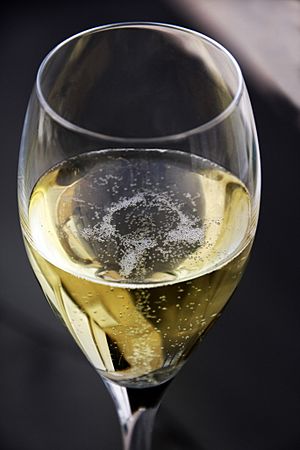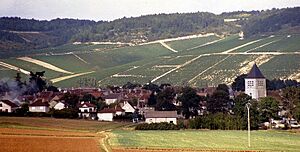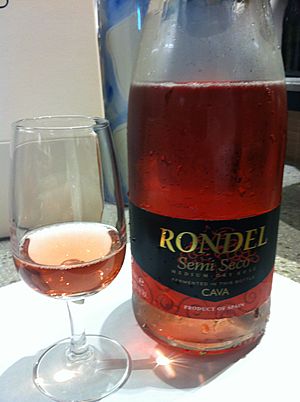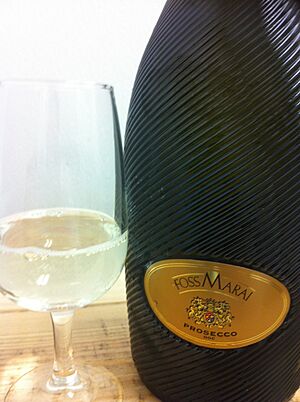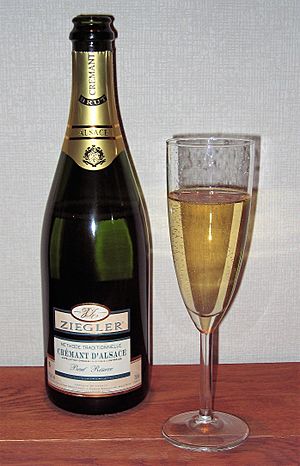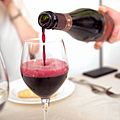Sparkling wine facts for kids
Sparkling wine is a type of wine that has lots of tiny bubbles, making it fizzy! These bubbles are made of carbon dioxide gas. Sometimes, the bubbles form naturally during the wine-making process called fermentation. Other times, they are added later. The most famous sparkling wine is Champagne, but there are many others around the world. For example, in Spain, it's called Cava. In Italy, you might hear Asti or Spumante. In Germany, it's known as Sekt. France also makes other sparkling wines like "Mousseux" or "Crémant", especially outside the Champagne region. Examples include Crémant d'Alsace, Blanquette de Limoux, and Clairette de Die. Most sparkling wines are made from white or rosé grapes.
Contents
What Makes Wine Fizzy?
Sparkling wine gets its bubbles from carbon dioxide gas. Think of it like soda pop, but instead of adding the gas directly, it's often created during the wine-making process.
How Bubbles Are Made
There are a few ways to get those bubbles into the wine:
- Natural Fermentation: This is the most common way. During fermentation, yeast eats the sugar in grape juice and turns it into alcohol and carbon dioxide. If this process happens in a sealed bottle or tank, the gas gets trapped, creating bubbles.
- Added Gas: Sometimes, carbon dioxide gas is simply added to the wine, just like in a soda machine. This is a quicker and cheaper way to make sparkling wine.
Famous Sparkling Wines Around the World
Sparkling wines are made all over the globe, and many countries have their own special names and styles.
Champagne from France
Champagne is probably the most famous sparkling wine. It comes from a specific region in France called Champagne. For a wine to be called "Champagne," it must be made in this region using traditional methods and specific types of grapes. It's often enjoyed for celebrations.
Cava from Spain
In Spain, sparkling wine is called Cava. Most Cava is made in the Catalonia region, near Barcelona. It's made using a similar traditional method to Champagne, which gives it fine bubbles and complex flavors. Cava can be white or rosé.
Prosecco and Asti from Italy
Italy has several popular sparkling wines:
- Prosecco: This is a very popular sparkling wine from the Veneto region in northeastern Italy. It's usually lighter and fruitier than Champagne or Cava, and it's often made using a different method that involves fermentation in large tanks.
- Asti Spumante: From the Piedmont region, Asti Spumante is a sweet, bubbly wine with a lower alcohol content. It's known for its fruity and floral aromas.
- Lambrusco: This is a unique sparkling red wine from Italy. It can be sweet or dry and is often enjoyed with food.
Sekt from Germany
In Germany, sparkling wine is known as Sekt. Most Sekt is made from grapes grown in Germany, and it can range from dry to sweet. It's a popular drink for celebrations in Germany.
Crémant from France (Outside Champagne)
France makes other excellent sparkling wines outside the Champagne region, which are often called "Crémant." These wines are also made using the traditional method, but they come from different areas like Alsace, Burgundy, or the Loire Valley. They offer a great taste of French sparkling wine at a different price.
How Sparkling Wine is Made
Making sparkling wine is a careful process. The most famous method is called the "traditional method" or "Champagne method."
The Traditional Method
1. First Fermentation: Grapes are pressed, and the juice ferments to make a still (non-bubbly) wine. 2. Blending: Different still wines are blended together to create the desired taste. 3. Second Fermentation: A small amount of sugar and yeast is added to the blended wine. This mixture is then put into strong glass bottles and sealed. 4. Bubbles Form: Inside the sealed bottle, the yeast eats the sugar, creating more alcohol and, importantly, carbon dioxide gas. Since the gas can't escape, it dissolves into the wine, making it fizzy. 5. Aging: The wine ages in the bottle, often for many months or even years. This gives it complex flavors. 6. Riddling: The bottles are slowly turned and tilted upside down over time. This helps the yeast sediment (dead yeast cells) collect in the neck of the bottle. 7. Disgorging: The neck of the bottle is frozen, and the frozen plug of sediment is removed. 8. Dosage: A small amount of wine and sugar (called liqueur d'expédition) is added to top up the bottle and adjust the sweetness level. 9. Corking: The bottle is then corked and ready to be enjoyed!
Other Methods
- Tank Method (Charmat Method): This method is often used for wines like Prosecco. The second fermentation happens in large, sealed tanks instead of individual bottles. This makes the process faster and less expensive, and it often results in lighter, fruitier wines.
- Transfer Method: This method is a mix of the traditional and tank methods. The second fermentation happens in bottles, but then the wine is transferred to a tank to remove the sediment before being bottled again.
Images for kids
-
A glass of Lambrusco from Italy
See also
 In Spanish: Vino espumoso para niños
In Spanish: Vino espumoso para niños


